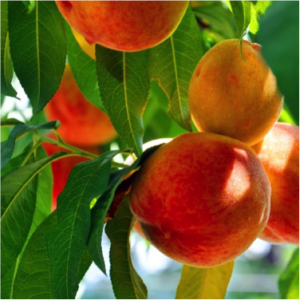Five Tips for Fruit Tree Success
There may be nothing quite as satisfying as plucking a fresh, ripe piece of fruit from your own backyard tree. Fruiting trees such as apple, pear, peach, citrus and others are among the most versatile and productive plants in the garden, capable of producing fruit for decades.
Fruit trees benefit from proper planting, routine care and optimum growing conditions. For maximum yield year after year, follow these five tips for fruit tree success:
1. Do your research first.
 Fruit trees are extremely diverse, and you can always find several types that thrive in your area. Take your garden’s climate, space, soil and sun exposure into account, and select a fruit tree that suits your needs. “Don’t forget to consider self-pollinating versus cross-pollinating varieties,” said tree expert Jeff Dinslage, president of NatureHills.com, America’s largest online nursery. “If you buy a single fruit tree that needs cross-pollination, all you’ll ever get are flowers.” So if you only have room for one fruit tree, consider a self-pollinating variety such as the Fuji Apple or ‘Flavortop’ Nectarine.
Fruit trees are extremely diverse, and you can always find several types that thrive in your area. Take your garden’s climate, space, soil and sun exposure into account, and select a fruit tree that suits your needs. “Don’t forget to consider self-pollinating versus cross-pollinating varieties,” said tree expert Jeff Dinslage, president of NatureHills.com, America’s largest online nursery. “If you buy a single fruit tree that needs cross-pollination, all you’ll ever get are flowers.” So if you only have room for one fruit tree, consider a self-pollinating variety such as the Fuji Apple or ‘Flavortop’ Nectarine.
2. Give young fruit trees plenty of TLC.
The day you bring your tree home and plant it in your garden is the most critical time in the tree’s life, and it’s important to provide proper care until it becomes fully established. “Proper care from the start is really important,” said Dinslage. “The care you give your tree during its first few years will affect its shape, strength, yield, and even lifespan.” To give your tree the best possible start, keep it well-watered, and offer extra protection from pests and inclement weather.
3. Prune correctly
Proper pruning is a must for a productive, happy fruit tree. Pruning your trees can give their leaves better access to light, keep messy growth to a minimum, and help them set bigger, juicier fruit. Remove dead wood, and thin out branches that cross each other. Every species of tree is different, so read up on when and how to prune your tree for best results.
4. Mulch and fertilize (but don’t overdo it)
Like pruning, mulching and feeding your fruit trees will keep them healthy and productive. Mulch your trees after planting and every spring and fall thereafter, taking care to leave room right around the base of the trunk. (Mulch piled high around the base of the tree can lead to rot). Feed your trees with a high-quality fertilizer throughout the growing season to encourage strong roots, a lush canopy and an abundant harvest.
5. Keep an eye out for problems, and act quickly.

Like all plants, fruit trees can be susceptible to blight, insects and other common problems. Keep one step ahead of disease and pests by preventing them in the first place and acting quickly to identify and treat anything that’s causing trouble. Research your fruit tree type and variety, and contact your local extension office for information on the most common pests and diseases to watch out for.
Growing fruit trees for that first homegrown harvest does take a little patience, but expert gardeners insist that they’re worth the initial effort. “A great harvest doesn’t happen overnight,” said Dinslage, “but fruit trees are one of the most rewarding plants a gardener can grow.”
For more information about fruit tree care and the wide variety of fruit trees available for growing in the US, visit www.NatureHills.com.
Posted in: Gardening
Leave a Comment (0) ↓